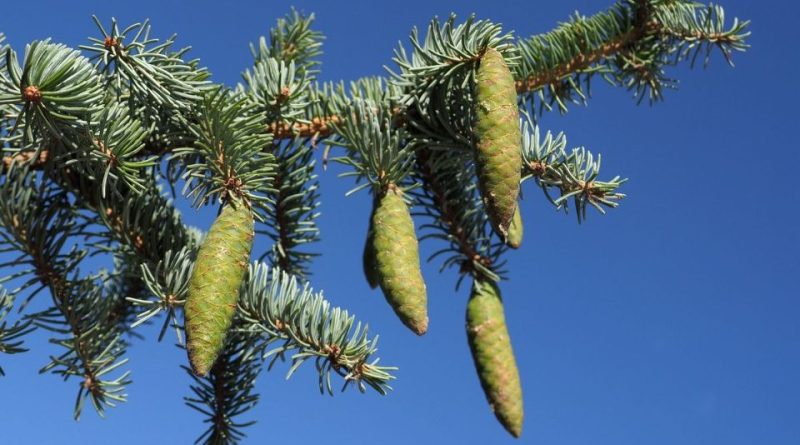Picea crassifolia
Picea crassifolia
The Qinghai spruce (Picea crassifolia, Kom., 1923) is an arboreal species belonging to the Pinaceae family.
Systematics –
From a systematic point of view it belongs to:
Eukaryota domain,
Kingdom Plantae,
Pinophyta division,
Class Pinopsida,
Pinales Order,
Pinaceae family,
Genus Picea,
P. crassifolia species.
The terms are synonyms:
– Picea schrenkiana var. crassifolia (Komarov) Komarov;
– Picea complanata var. crassifolia (Komarov) Gaussen (Farjon 1990).
Etymology –
The term picea is the Latin name of the wild pine in Virgil and Pliny and could, according to an etymological interpretation, derive from Pix picis = pitch, in reference to the abundant production of resin.
The specific epithet crassifolia derives from the Latin which means with thick leaves; in reference to the morphology of the needles of this plant.
Geographic Distribution and Habitat –
Picea crassifolia is a conifer endemic to Gansu, Qinghai (Qilian Shan), Inner Mongolia (Daqing Shan), Ningxia (Helan Mountains), China.
Its habitat in its area is that of north-facing slopes, at altitudes between 1600 and 3800 m, surmounting steppes and desert areas, both on calcareous and non-calcareous soils. The reference climate is the cold and dry continental, with most of the precipitation falling as snow. It is a typical species of pure forests, locally in association with Betula albosinensis and Populus tremula.
Description –
Picea crassifolia is a conifer that grows up to 25 m in height and with a trunk diameter of up to 60 cm and with a red-brown, wrinkled and flaky bark.
The crown is pyramidal or strictly conical, open in older specimens.
The branches are greenish-yellow, turning pink or brownish yellow. Those of the first order are short, horizontal or turned up; those of the second order are always short, rigid and ascending; the shoots, also rigid, are often pruinose, yellow-orange or yellow-greenish, then grey, with prominent grooves, glabrous or with scattered pubescences. The pulvini are 2-2.5 mm, erect or curved.
The leaves are inserted radially, often ascending on the upper side of the twigs; they are robust, with a quadrangular section, 12-35×2-3 mm, with stomata in 5-7 lines above and 4-6 lines below the leaf.
The male cones are carried in the axillary position, 1-1.5 cm long, of a yellowish-pink colour.
The female cones are oblong-ovoid or cylindrical, sessile, initially erect and then hanging when ripe, 7-11 cm long and 2,5-3,5 cm broad, with obtuse apex, initially red-purple, then green when ripe with the margins of the brown scales. The macrosporophylls, 15-20 mm long and 10-17 mm broad, are obovate-flabellate, slightly convex, with a smooth surface, usually finely striated, glabrous; their bracts are rudimentary, ligulate, entirely hidden.
The seeds are brown, oblong-ovoid in shape, 3-3.5 mm long, with a 10-13 mm winged part, brown-orange in colour.
Cultivation –
Picea crassifolia is a conifer endemic to an area of China, where it grows in China, in the mountainous areas of Helan Shan, Daqing Shan, in Gansu, Ningxia, north-east of Qinghai (Qilian Shan and surroundings of Qinghai Hu), in a mountain area at altitudes between 1600 and 3800 m a.s.l..
This plant has a cold hardiness limit between -28.8°C and -23.3°C.
It is a plant that is used for its wood while it is very rare as an ornamental being rarely present in parks or botanical gardens.
It reproduces by seed.
Customs and Traditions –
Picea crassifolia is a pinaceae whose species rank many authors dispute, considering it a variety of P. schrenkiana.
The wood of this plant is used only locally (probably as fuel) as the range coincides with areas far from urban centers and major communication routes.
As mentioned, its cultivation and its presence as an ornamental plant in western and Asian vegetable gardens and botanical gardens is also rare. When grown in Western Europe it develops leaves that are longer and flatter than those found naturally in its area of origin.
A few specimens of this plant are reported in Scottish botanic gardens, including a group of trees from a 1980 accession from Qinghai found in the Dawyck Botanic Garden.
As regards its cultivation status, according to the IUCN Red List, there is no evidence of decline of the subpopulations, which grow in areas not subject to relevant anthropic risks. For this reason it is classified as a species of least risk (LC).
Method of Preparation –
Picea crassifolia is an endemic plant of an area of China which in its area is most likely used as timber.
There are no known alternative uses, while those of ornamental use are rare.
Guido Bissanti
Sources
– Acta Plantarum – Flora of the Italian Regions.
– Wikipedia, the free encyclopedia.
– GBIF, the Global Biodiversity Information Facility.
– Useful Tropical Plants Database.
– Conti F., Abbate G., Alessandrini A., Blasi C. (ed.), 2005. An annotated checklist of the Italian vascular flora, Palombi Editore.
– Pignatti S., 1982. Flora of Italy, Edagricole, Bologna.
– Treben M., 2000. Health from the Lord’s Pharmacy, Advice and experiences with medicinal herbs, Ennsthaler Editore.
Photo source:
– https://sweetgum.nybg.org/images3/3882/571/04277835.jpg
– https://powo.science.kew.org/taxon/urn:lsid:ipni.org:names:676948-1
Attention: The pharmaceutical applications and alimurgical uses are indicated for informational purposes only, they do not in any way represent a medical prescription; we therefore decline all responsibility for their use for curative, aesthetic or food purposes.


